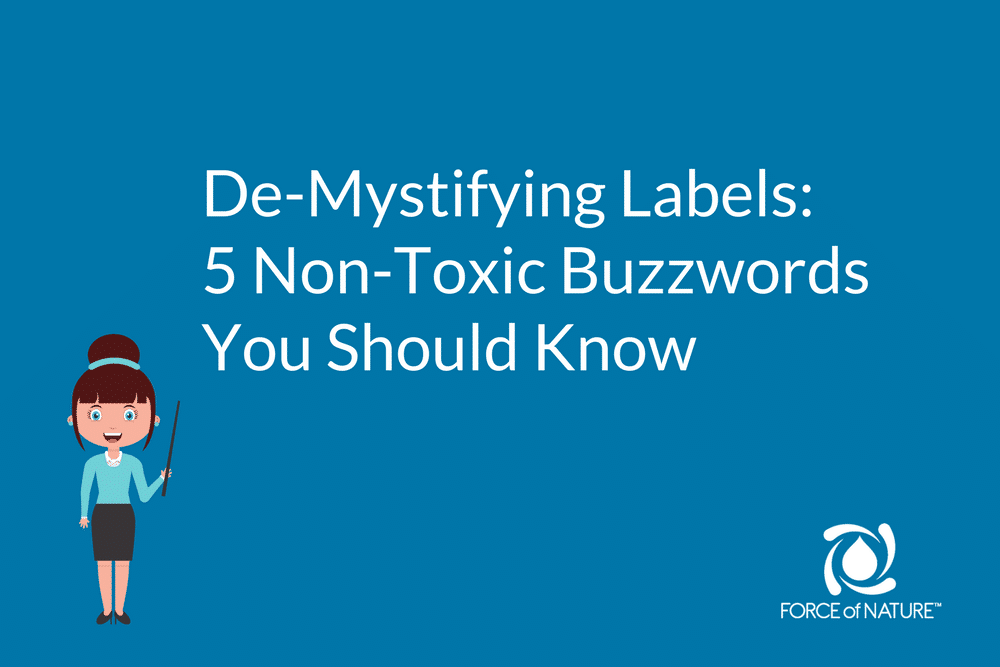
Remember the old days, before you knew about the importance of using non-toxic products in your home and you could just wander the household aisle, picking products based on scent or sale price? It’s hard out here in the non-toxic trenches, where the packaging claims and ingredient lists are cryptic puzzles that seem designed to confuse us! We hope to make it a little easier with this list of some commonly used household & personal care product claims to watch out for.
5 Non-Toxic Buzzwords To Watch Out For
Hypoallergenic
It’s hard not to get angry about this one. “Hypoallergenic” products sound like the type of product that would be gentler for those with allergies and sensitivities. The truth is, it is 100% completely meaningless. It’s a term that is not governed by any government agency and is defined by the FDA as “whatever a particular company wants it to mean.” Mike drop.
Your best bet: Use Mayo Clinic’s SkinSafe to research ingredients & products. This site makes it super easy to find products that are 100% free of the most common allergens as well as identify the most problematic ingredients. Another alternative is to simply rule out the ingredients most commonly associated with allergies: fragrances, MIT & CMIT. On fragrances, even so-called “natural fragrances,” can contain ingredients that are allergens (not to mention having been linked to health risks including hormone disruption, asthma, neurotoxins and carcinogens!) And watch out for products labeled “unscented”, because even those can contain masking fragrances. For preservatives, you’ll want to avoid for MIT & CMIT (methylisothiazolinone & methylchloroisothiazolinone). These preservatives are extremely common in “natural” cleaners, detergents & personal care products and should be avoided as well if you have any allergy concerns.
Natural
This one’s no good either. In terms of food, at least the FDA mandates that a product not contain any artificial or synthetic, including color additives. But the term doesn’t extend to how a raw ingredient is treated (for example, if it’s treated with pesticides) and the agency’s position is that it is difficult to define — so much so that they’re actually looking for feedback from consumers on how to do so. When it comes to household & personal care products, the term is really meaningless. Neither the FDA nor EPA set criteria for products labelled as “natural”. That’s why “natural” personal care and household products can contain endocrine disruptors like phthalates and parabens. And, as is often said, not everything “natural” is also safe; poison ivy and arsenic are natural!
Your best bet: leave this term out of your repertoire and instead get versed on ingredient safety, so you can quickly weed out toxin chemicals. Learn more about some of the other most common culprits like of toxicity like fragrance, parabens, methylisothiazolinone (MIT), methylchloroisothiazolinone (CMIT) here.
Clean
The term “clean” is so lovely and…clean-sounding. In terms of any formal definition or its trustworthiness in terms of the safety of a product, however, it’s pretty worthless. While many companies use it to help designate their non-toxic product as one free of common pitfalls in their category such as phthalates and parabens, the term “clean” doesn’t tell you any of this.
Organic
This one is tricky. Technically, in order for an item to be part of the National Organic Program, 70% if its ingredients must be organic. So something that contains 30% non-organic ingredients can still claim “Made With Organic” on its label. To earn the USDA Certified Organic seal, that number bumps up to 95% or greater organic ingredients. However, the USDA only has jurisdiction over agricultural products (like your fruits and veggies), which does not include personal care or household cleaning products. That means when it comes to personal care or household cleaning products, if you see the word “organic”, don’t assume there is anything safer about the product.
Your best bet: Check out products & ingredients on databases like the EWG Guide to Healthy Cleaning & Skin Deep.
Phosphate-Free
Phosphates were used in laundry and dishwashing detergents to suspend food and grease, helping to clean clothing and dishes more thoroughly. Unfortunately, phosphates also aid in the growth of plants and their presence in wastewater causes harmful algae to bloom in our oceans and rivers. This has led to their ban. Manufacturers are now prohibited from using phosphates in products, so using “phosphate-free” claims on packaging claims is meaningless.
Your best bet: check out our guides on how to choose a non-toxic product for your laundry detergent and dishwashing detergent.
Our advice overall: when you see the terms noted here, skip right past them to the ingredient label itself. As you seek out non-toxic products, harness the power of resources like SkinSafe & EWG to help you learn to decode labels. Our blog is always chock full of info, and we’re here with our non-toxic, family-safe cleaning system, Force of Nature, which is 100% free of toxic chemicals.



